Feed intake of the dry cow
Feeding the Dry Cow
Published: January 1, 2002
By: Fernando Diaz Royon, DVM, Alvaro Garcia, DVM Ph.D, Kenneth Kalscheur, Ph.D (South Dakota State University)
Under ideal conditions, dairy cows produce milk during 305 days of the year and are dry the remaining 60 (table 1). In reality, feeding for high production should begin during the dry period or towards the end of the previous lactation. With dry periods shorter than 40 days, there´s not enough time to regenerate the mammary tissue; this may result in production losses of 20–40% during the next lactation. Dry periods longer than 70 days do not promote an increase in production and may result in calving difficulties that are costly to the producer.
Table 1. Dry period: Average days by herd size in U.S. dairies.

Recent research has demonstrated that the minimum days dry to maximize production depends on parity (Kuhn et al., 2006). Cows of first and second lactation had little production losses with shorter periods of 40 to 45 days. For mature cows, dry periods of 50 to 65 days were needed, probably because they are less persistent. The authors concluded dry periods shorter than 30 days and longer than 70 days reduced lifetime productivity, with the impact of dry periods in excess of 80 days even worse than those shorter than 30 days. One advantage of 40-day dry periods is that cows can be maintained in a higher energy plane of nutrition, which reduces the negative energy balance after calving and, therefore, fat mobilization. Up to 2007, only 14% of the dairy herds in the U.S. had dry periods between 40 and 49 days, with the majority (51.8%) between 60 and 69 (table 2).
Table 2. Average days dry at U.S. dairies.
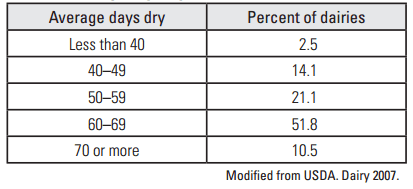
FEEDING
In the past, dry dairy cows were fed diets of low-energy content, at best supplemented with some concentrate as calving approached. It is an increasingly common management practice to separate dry cows into "far-off" (first 30 days) and "close-up" (last 30 days). The feasibility of grouping cows is related with the facilities available on the farm, which is why in the U.S. twice as many large dairies as small dairies have close-up groups (table 3).
Table 3. Percent of operations that group close-up cows by size (number of cows).

Far-off dry cows
According to the NRC (2001), the nutrient content of dry cow diets during their first 30 days should be the following (DM basis): 12% crude protein (CP), 0.59 Mcal NEL/lb., 27% ADF, 35% NDF, 0.37% Ca, 0.26% P, 1800 IU vitamin A, 540 IU vitamin D, and 7 IU vitamin E per lb. It is also important adhere to the following general management practices:
According to the NRC (2001), the nutrient content of dry cow diets during their first 30 days should be the following (DM basis): 12% crude protein (CP), 0.59 Mcal NEL/lb., 27% ADF, 35% NDF, 0.37% Ca, 0.26% P, 1800 IU vitamin A, 540 IU vitamin D, and 7 IU vitamin E per lb. It is also important adhere to the following general management practices:
- Supply a minimum of 1% of body weight of large-particle-size forage (hay). Grass hay should be given priority, as high calcium and low phosphorus in legumes can increase the incidence of hypocalcemia; administering enough fiber minimizes digestive upsets following calving.
- Avoid administering corn silage free-choice, as it results in excessive energy intake and increases the possibility of DAs and fatty livers.
- Limit grain intake to the amounts required to fulfill the requirements of energy and protein.
- Maintain calcium intake under 3 ounces per day, while at the same time supply adequate amounts of phosphorus (1.3 to 1.5 ounces/d) to minimize the incidence of hypocalcemia.
The far-off dry group can be further divided into one group that needs to gain weight and another that needs to maintain it. The objective is always to maintain or improve body condition without fattening. Under no condition should dry cows be allowed to lose weight, because the risks of dystocia and culling during the following lactation will increase. In order to do this, it is important to consider the impact days pregnant has on their daily feed intake (table 4).
Table 4. Feed intake of the dry cow*.

Close-up dry cows
The last 3 weeks precalving (close-up cows) and the first 3 weeks post calving are called the "transition period" (Grummer, 1995). Most of the metabolic problems of the dairy cow happen during the first two weeks of the lactation, and even infectious processes (e.g., mastitis, paratuberculosis, salmonellosis, etc.) start to manifest themselves clinically during this period (Goff and Horst 1997). Health problems during the transition period have a negative impact on the profitability of the operation due to increased veterinary expenses, reduced production, reduced reproduction performance, early culls, and deaths. Despite increased research studying the transition period, these problems continue to manifest themselves and have even increased over the last 11 years (table 5). This increase is likely associated with the parallel genetic improvement and resulting milk production increase per cow.
The last 3 weeks precalving (close-up cows) and the first 3 weeks post calving are called the "transition period" (Grummer, 1995). Most of the metabolic problems of the dairy cow happen during the first two weeks of the lactation, and even infectious processes (e.g., mastitis, paratuberculosis, salmonellosis, etc.) start to manifest themselves clinically during this period (Goff and Horst 1997). Health problems during the transition period have a negative impact on the profitability of the operation due to increased veterinary expenses, reduced production, reduced reproduction performance, early culls, and deaths. Despite increased research studying the transition period, these problems continue to manifest themselves and have even increased over the last 11 years (table 5). This increase is likely associated with the parallel genetic improvement and resulting milk production increase per cow.
Table 5. Percent of U.S. cows with clinical problems.
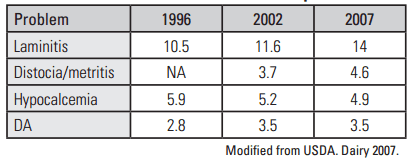
During the last 3 weeks of gestation, the requirements for energy increase due to fetal development and colostrum production. The mammary gland at 4 days postcalving has increased demands for glucose (3X), amino acids (2X), and fatty acids (3X) when compared to the gravid uterus at 250 days of gestation (Bell, 1995). At the same time, dry-matter intake (DMI) is reduced by almost 30% during the last 3 weeks of gestation, which is attributed to the high estrogen concentration around calving (Grummer, 1993). This mismatch between nutrient intake and demand generates a negative energy balance (NEB) towards the end of the pregnancy that is prolonged for several weeks after calving. Nearly 25% of the cows that left the herd in Minnesota between 1996 and 2001 did so during the first 60 days in milk (DIM) (Godden et al. 2003). In a review of 26 experiments, a positive energy balance was achieved at 50 DIM with a maximum NEB at 11 days postcalving (Brixy 2005). This period has been associated with immunosuppresion, precalving problems, and increased interval to first insemination.
Recent research suggests cows arrive at the dry period with BCS of 3.0 instead of the previous recommendation of 3.5–3.75 (Contreras et al., 2004). This BCS has to be maintained until calving (Brand, 1996), as cows gain BCS more efficiently during lactation than during the dry period, due to differences in nutrient partition between both periods. Cows with lower BCS at dry-off have a tendency to put on weight, while those with high BCS tend to lose it during the dry period (Bar, 2001). Hayirli et al. (2002) found that feed intake around calving drops linearly as BCS increases, as a result of greater mobilizations of body reserves. In reality, cows with higher BCS represent a greater problem than cows with lower than desired BCS. Dry cows carrying excessive condition are more susceptible to develop cystic ovaries and other reproductive problems, hoof problems after calving, retained membranes, displaced abomasums, and ketosis.
ENERGY NEEDS
The NRC (2001) suggests an increase of 0.14–0.18 Mcal NEl/lb. of feed during the three last weeks of gestation, to achieve a final energy density of 0.7–0.74 Mcal NEl/lb. The most effective alternative to increase energy in the transition diet is to increase the concentration of non-fibrous carbohydrates (NFC), because they allow for the adaptation of the rumen to high-production diets postcalving. There are two sites for this adaptation to occur:
1) rumen microorganisms2) rumen papillae
When significant amounts of NFC (i.e., cereal grains) are incorporated into the diet, bacteria that utilize starch develop rapidly (3–5 days). Large quantities of volatile fatty acids (VFA), propionic acid in particular, are produced, which stimulates the development of rumen papillae in a process that requires 4 to 6 weeks (Dirksen et al., 1985). The growth of bacteria that utilize lactic acid originating from propionic is also slow (3–4 weeks). This results in an accumulation of lactic acid (Calsamiglia, 1995). The time gap between VFA production and development of rumen papillae leads to an accumulation of VFA and gas with the subsequent risk of acidosis and displaced abomasum (DA).
The maximum concentration of NFC in precalving diets should not exceed 43% of the DM (NRC, 2001). This is consistent with experiments that suggest that diets precalving with high NFC (43–45%) accentuate the DMI depression (Minor et al. 1998; Rabelo et al. 2003). Six experiments analyzed the effect of NFC concentration (high or low) in precalving diets. Although the range of NFC was large (18–45%), most experiments reported higher DMI precalving with the higher NFC diets, provided they did not exceed 43% of DM (Overton and Waldron 2004). These results are consistent with those of Hayirli et al. (2002), who suggested that DMI precalving was positively correlated with NFC content of the diet. Available data suggests that diets with moderate concentrations of NFC (36–38%) are adequate for precalving (Overton, 2004).
Although based in sound research, the ability of these high-energy diets to decrease the incidence of disease and improve production is inconsistent (Drackley, 2007). Based on the NRC requirements, Drackley et al. (2007) observed that a Holstein cow weighing 1,496 lbs. required 14–15 Mcal NEl daily. These researchers recommended that dry period and precalving diets should be 0.59–0.63 Mcal NEl/lb. DM for an estimated DMI of 25 to 28 lbs. per day. The best way to achieve this low energy density is by diet dilution with finely chopped straw.
The effects of the energy level (high and low) in precalving diets on energy metabolism, production, and prevalence of peripartum diseases are presented in table 6. Most experiments reported benefits when diets high in energy were fed as suggested by the NRC (2001). Conversely, data collected by the European company Keenan from 27,000 cows and 277 herds show a positive effect in the reduction of the prevalence of problems around calving when the energy of the diet was diluted with straw (Drackley, 2007). It has to be noted that in the experiments by Drackley et al. (2007) cows were housed and fed individually, not allowing for social interaction and competition as it would happen in a commercial dairy operation. It is possible that the apparent success of these types of diets in the field maybe more attributed to the low K content in the straw altering the DCAD balance and reducing the incidence of hypocalcemia than to the lower energy density. In addition, none of these studies has evaluated the reduction of microbial protein synthesis as a result of reduced supply of NFC. Possible collateral effects due to reduced colostrum production and/or lower weight and survival of calves born to cows with restricted dietary energy intake need to be considered. Two examples of commercial close-up diets with high and low energy contents are presented in table 7.
PROTEIN NEEDS
Fetal growth, udder development, and colostrum synthesis are greatly responsible for the increase in protein needs during the last three weeks of gestation. This nutrient increase is parallel to a DMI reduction, which causes a negative protein balance. In contrast with the NEB and fat removal, protein mobilization is limited, and once the reserves are depleted, milk production and synthesis of immunoglobulins are compromised.
Table 6. Effects of the energy concentration in precalving diets.
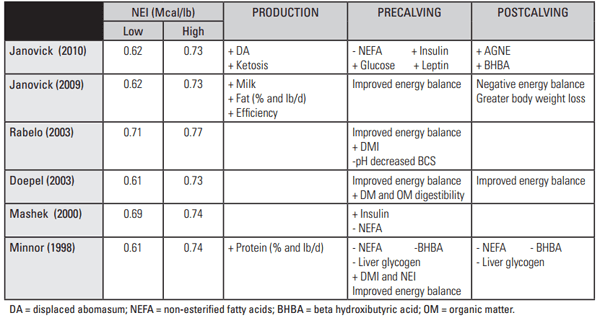
The NRC (2001) suggests springing heifers should be fed precalving diets with 13.5–15% CP, whereas mature dry cows can be fed diets containing 12% CP. Other authors (Overton, 2004; Park et al., 2002), consider 12% too low for mature cows. According to Overton (2004), diets in the field are usually formulated to supply between 2.4 and 2.6 lb./per day of metabolizable protein (MP). This can be achieved with diets that contain approximately 13–15% CP and 36% NFC (based on 24–26 lb. DMI/day). The content of lysine and methionine should be above 6 and 2 % of MP, respectively (CNCPS, 2009).
CALCIUM HOMEOSTASIS
At calving, calcium requirements are quadrupled, which results in cows experiencing variable degrees of subclinical to clinical hypocalcemia (Horst et al., 1997). To improve calcium mobilization, Goff and Horst (1997) suggested to generate a light metabolic acidosis by modifying the equilibrium between anions and cations (Na+K)-(Cl+S) in the diet. The use of salts rich in anions (ammonium sulphate and chloride are the most frequent) or supplements with hydrochloric or sulphuric acids is currently recommended. One constraint is the reduction in intake caused by the low palatability of these salts. In addition, they are expensive, and because there is commonly only one closeup lot, they are also administered to springing heifers, which generally do not benefit from supplementation.
Table 7. Commercial precalving diets with different energy concentrations.
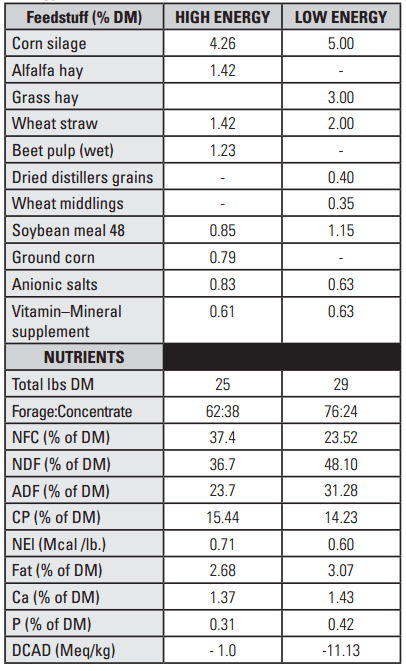
Use of anionic salts in precalving diets in the U.S. is currently not widespread, with only 23% of the dairy herds using them (APHIS, 2007).
A more economical and easier way to generate metabolic acidosis in cows is to decrease the cations in the diet. Care has to be taken so that particular minerals do not fall below their requirements. In particular, watch for concentrations of Na and Mg, which may already be low in some feedstuffs. Goff and Horst (1997) reported that reducing the potassium concentration in the diet to 1.1% prevented the occurrence of clinical hypocalcemia in multiparous Jersey cows. Many producers in the Midwest control hypocalcemia by using forages with low concentrations of potassium with the objective to achieve less than 1.3 % in the diet DM. (Overton, 2004).
Important facts about potassium (K):
• Some plants accumulate K in their tissues at concentrations greater than those required by the animal.
• Grasses generally have less K than legumes (1.68% vs. 2.55%).
• K´s concentration decreases with plant maturity.
• Hay has less K than silage.
• Nearly 86% of the K ingested is excreted in the urine.
Dairy producers might find useful to identify a field on the farm that has low soil potassium concentration and use it exclusively to grow forages for close-up diets. Soil fertilization (both organic and/or inorganic) has to be managed in order to reduce the potassium input. Periodically test the soil to be sure that the concentration is adequate.
SUMMARY
Body condition has to be monitored throughout lactation to make sure cows arrive to the dry period with optimum level of body reserves (BCS=3). Current research suggests that traditional dry periods (50–60 days) with two different feeding groups, faroff and close-up, reduce metabolic problems during transition. It is necessary to maintain a lower nutrition plane during the first 5 weeks and increase energy and protein density in the diet during the 3 weeks prior to calving. This approach maintains their condition throughout the dry period and adapts them physiologically to the more nutrient dense diet postcalving.
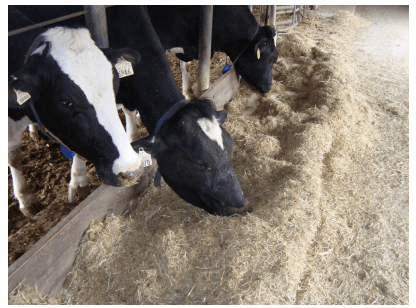
Dry cows fed a low-energy diet in the Dairy Research and Training facilities at SDSU.
REFERENCES
Agenas S., E. Burstedt and K. Holtenius. 2003. Effects of feeding intensity during the dry period. 1. Feed intake, body weight and milk production. Journal of Dairy Science: 86:870-882.
APHIS. USDA. Dairy 2007. Part I: Reference of Dairy Cattle Health and Management Practices in the United States. http://www.aphis.usda. gov/animal_health/nahms/dairy/downloads/dairy07/ Dairy07_dr_PartI.pdf
APHIS. USDA. Dairy 2007. http://nahms.aphis.usda.gov
Bar D. 2001. Implementation of a body condition scoring program, Dansk Kvaegfagdyrlaegers Arsmode. Pp. 4.1-4.6.
Bell A.W. 1995. Regulation of organic nutrient metabolism during transition from late pregnancy to early lactation. J. Anim. Sci: 73:2804-2819
Brand A., J.P.T.M. Noodhuizen and Y.H. Schukken. 1996. Herd health and production management in dairy practice. Wageningen Pers.
Brixy, J.D. 2005. Validation of a prediction equation for energy balance in Holstein cows and heifers. M.S. Thesis. University of Idaho, Moscow.
Calsamiglia, S. 2000. Nuevos avances en el manejo y alimentación de la vaca durante el preparto. XVI Curso de Especialización FEDNA.
Contreras, L.L., C.M. Ryan, and T.R. Overton. 2004. Effects of dry cow grouping strategy and prepartum body condition score on performance and health of transition dairy cows. Journal of Dairy Science: 87:517-523.
Coppock, C.E., R.W. Everett, R.P. Natzque, and H.R. Ainslie. 1974. Effect of Dry Period Length on Holstein Milk Production and Selected Disorders at Parturition. Journal of Dairy Science: 57:712-718.
Coppock, C.E., R.W. Everett, R.P. Natzque, and H.R. Ainslie. 1974. Effect of Dry Period Length on Holstein Milk Production and Selected Disorders at Parturition. Journal of Dairy Science: 57:712-718.
Dirksen, G., H. Liebich and K. Mayer. 1985. Adaptive changues of the ruminal mucosa and functional and clinical significance. Bov. Prac. 20:116-120.
Doepel L., H. Lapierre, and J.J. Kenelly. 2002. Peripartum Performance and Metabolism of Dairy Cows in Response to Prepartum Energy and Protein Intake: 85-2315-2334.
Drackley, J.K. 2007. Rethinking Nutritional Management During the Dry Period and Transition. Southeast Dairy Herd Management Conference. 57:70.
Godden, S.M., S.C. Stewart, J.F. Fetrow, P. Rapnicki, R.Cady, W. Weiland, H. Spencer, and S.W. Eicker. 2003. The relationship between herd rbST- supplementation and other factors and risk for removal for cows in Minnesota Holstein dairy herds. Pages 55-64 in Proc. Four-State Nutr. Conf. LaCrosse, WI. MidWest Plan Service publication MWPS-4SD16.
Goff, J.P. and R.J. Horst. 1997. Effect of dietary potassium and sodium, but no calcium, on the incidence of milk fever in dairy cows. Journal of Dairy Science: 80:176.
Grummer, R.R. 1993. Etiology of lipid-related metabolic disorders in periparturient dairy cows. Journal of Dairy Sience. 76:3882-3896.
Grummer, R.R. 1995.Impact of charges in organic nutrient metabolism on feeding the transition dairy cows. Journal Animal Sience. 73:2820-2833.
Hayirli, A., R.R. Grummer, E. V. Nordheim, and P.M. Crump. 2002. Animal and Dietary Factors Affecting Feed Intake During The Prefesh Transition Period in Holsteins. Journal of Dairy Science: 85:3430-3443.
Horst R.L., J.P. Goff, T.A. Reinhardt, and D.R. Buxton. Strategies for Preventing Milk Fever in Dairy Cattle. 1997. Journal of Dairy Science: 80: 1269-1280.
Janovick, N.A., Y.R. Boisclair, and J.K. Drackley. 2011. Prepartum dietary energy intake affects metabolism and health during the periparturient period in primiparous and multiparous Holstein cows. Journal of Dairy Science: 94:1385-1400.
Janovick, N.A. and J.K. Drackley. 2010. Prepartum dietary management of energy intake affects postpartum intake and lactation performance by primiparous and multiparous Holstein cows. Journal of Dairy Science: 93:3086- 3102.
Janovick, N.A., N.B. Litherland, K.M. Moyes, and J.K. Drackley. 2006. Prepartum energy intake effects on health and lactational performance in primiparous and multiparous Holsteins cows. Journal of Dairy Science: 89 (Suppl. 1). (Abstr.).
Kuhn, M.T., J.L. Hutchison, and H.D. Norman. 2006. Dry Period Length to Maximize Production Across Adjacent Lactations and Lifetime Production. Journal of Dairy Science: 89:5 1713-1722.
Mashek D.G. and D.K. Beede. 2000. Peripartum Responses of Dairy Cows to Partial Substitution of Corn Silage with Corn Grain in Diets Fed During the Late Dry Period. Journal of Dairy Science: 83:2310-2318.
Minor D.J., S.L. Trower, B.D. Strang, R.D. Shaver, and R.R. Grummer. 1998. Effects of Nonfiber Carbohydrate and Niacin on Periparturient Metabolic Status and Lactation of Dairy Cows. Journal of Dairy Science: 81:189-200.
National Research Council. 2001. Nutrient Requeriments of Dairy Cattle. 7th rev. ed. Natl. Acad. Sci., Washington DC.
Overton T.R. 2004. Optimizing the Transition Cow Management System on Commercial Dairy Farms. Florida Ruminant Nutrition Symposium. 68-79.
Overton T.R. and M.R. Waldron. 2004. Nutritional Management of Transition Dairy Cows: Strategies to Optimize Metabolic Health. Journal of Dairy Science: 87E. Suppl.):E105-E119.
Park, A.F., J.E. Shirley, E.C. Titgemeyer, M.J. Meyer, M.J.VanBaale, and M.J. VandeHaart. 2002. Effect of Protein Level in Prepartum Diets on Metabolism and Performance of Dairy Cows. Journal of Dairy Science: 85:1815-1828.
Rabelo E., R.L. Rezende, S.J. Bertics, and R.R. Grummer. 2003. Effects of Transition Diets Varying in Dietary Energy Density on Lactation Performance and Ruminal Parameters of Dairy Cows. Journal of Dairy Science: 86:916-925.
This article was originally published in the South Dakota State University Website. Engormix.com thanks for this huge contribution.
Related topics:
Authors:
South Dakota State University
South Dakota State University
Recommend
Comment
Share
Recommend
Reply
Recommend
Reply
26 de junio de 2012
Good article which gives basic rules of dry cow management. I strongly suggest to read and evaluate this article for your herd If you are dairymen.
Recommend
Reply

Would you like to discuss another topic? Create a new post to engage with experts in the community.









.jpg&w=3840&q=75)